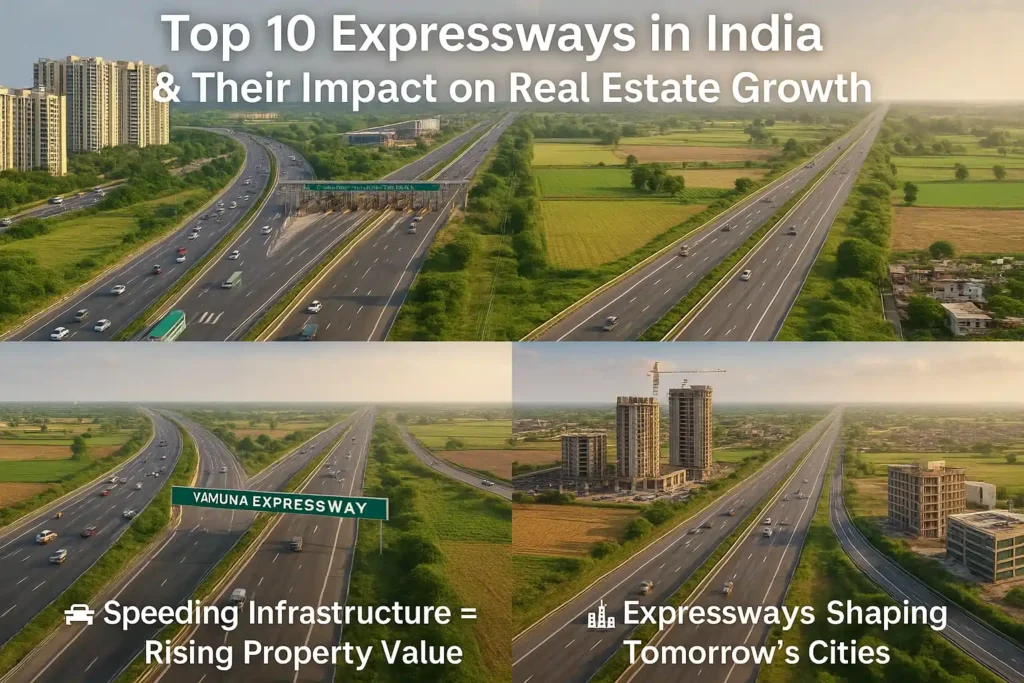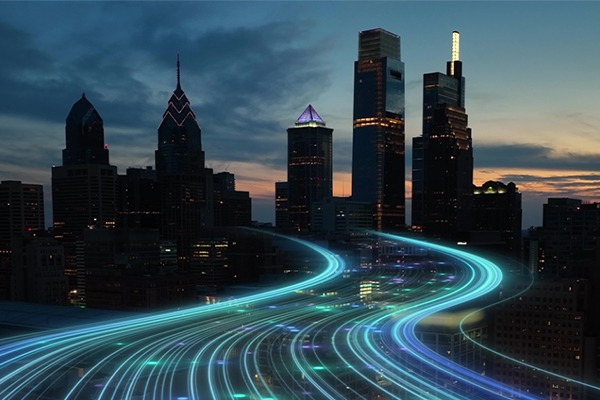India is witnessing an infrastructure revolution, and at the heart of this transformation lies the country’s rapidly expanding network of expressways. These mega road projects are not only reducing travel time but also accelerating regional development. Most importantly, they are unlocking massive real estate potential in the areas they traverse. From new townships to logistics parks, expressways are reshaping India’s property landscape.

1. Delhi–Mumbai Expressway (Approx. 1,350 km)
The Delhi–Mumbai Expressway is a game-changer, connecting the capital city to the financial hub across six states. Once fully operational, it will reduce travel time by 50% and trigger a real estate boom in key nodes such as Jaipur, Kota, Bharuch, and Surat. Large-scale logistics parks, integrated townships, and smart cities are being planned along this corridor, making it a hotspot for long-term investment.
2. Surat–Chennai Expressway (Approx. 1,271 km)
This upcoming six-lane greenfield expressway will connect Gujarat to Tamil Nadu. It will slash travel time from around 35 to 16 hours and pass through Maharashtra, Karnataka, and Andhra Pradesh. The project is expected to stimulate the growth of industrial zones, warehousing hubs, and residential colonies, especially in lesser-known towns along the route.
3. Amritsar–Jamnagar Expressway (Approx. 1,257 km)
A key component of the Bharatmala project, this expressway will drastically improve connectivity between Punjab and Gujarat. With faster access to major refineries, ports, and industrial centers, this corridor is fueling land demand for warehousing, commercial real estate, and residential plots.
4. Ganga Expressway (Approx. 594 km)
Stretching from Meerut to Prayagraj in Uttar Pradesh, the Ganga Expressway is one of the most ambitious infrastructure projects in the state. It will significantly reduce travel time and stimulate development in cities like Meerut, Hardoi, and Raebareli. Residential townships, smart cities, and logistic hubs are already under planning along its path.
5. Purvanchal Expressway (Approx. 340 km)
Operational since 2021, the Purvanchal Expressway links Lucknow to Ghazipur. It has opened up eastern Uttar Pradesh for industrial and residential expansion. Several townships, schools, hospitals, and manufacturing units are already being developed in areas previously considered remote.
6. Agra–Lucknow Expressway (Approx. 302 km)
One of the earliest success stories, this expressway has drastically cut travel time between Agra and Lucknow. The corridor is now seeing a rise in demand for mid-income and luxury housing, with several real estate developers launching projects in Etawah, Kannauj, and Firozabad.
7. Bundelkhand Expressway (Approx. 296 km)
Launched in 2022, this expressway connects Etawah to Chitrakoot and acts as a feeder to both Yamuna and Agra–Lucknow Expressways. It is rapidly unlocking the economic potential of the backward Bundelkhand region, where multiple real estate and industrial projects are now being planned.
8. Mumbai–Nagpur Expressway (Samruddhi Mahamarg) (Approx. 701 km)
This high-speed corridor connects Maharashtra’s capital with the eastern part of the state. Known as Samruddhi Mahamarg, the expressway is reducing travel time significantly and has triggered a flurry of real estate activity in cities like Aurangabad, Nashik, and Wardha. Industrial parks and smart cities are being built to capitalize on the improved connectivity.
9. Bengaluru–Chennai Expressway (Approx. 260 km)
Currently under construction, this expressway will cut travel time between the two metro cities to just under three hours. It is expected to transform regions like Hoskote, Kolar, Sriperumbudur, and Arakkonam into thriving real estate and industrial zones. Land prices in these areas have already seen exponential growth in anticipation of the expressway.
10. Dwarka Expressway (Approx. 28 km)
Though shorter in length, the Dwarka Expressway is among the most impactful in terms of real estate. It connects Dwarka in Delhi to Gurugram in Haryana and has emerged as one of the fastest-growing property corridors in the NCR. Residential property prices have doubled over the past four years, and developers are launching luxury and mid-income housing projects, commercial spaces, and retail hubs.
How Expressways Are Fueling Real Estate Growth
1. Improved Connectivity
Expressways cut down travel time and bring remote areas closer to urban centers. This increased accessibility encourages people to consider newer micro-markets for residential and commercial purposes.
2. Infrastructure Development
Government policies are supporting integrated development with expressways. Along with roads, there is investment in power, water, metro stations, and social infrastructure, making these areas livable and investment-worthy.
3. Price Appreciation
As connectivity improves, so does demand. This naturally leads to an increase in land and property prices. For example, prices along the Dwarka Expressway have nearly doubled within a few years.
4. Industrial and Commercial Hubs
Many expressways are being planned in sync with industrial corridors and logistics parks, creating employment opportunities and boosting the demand for rental housing and retail real estate.
The expansion of India’s expressway network is not just a transport revolution—it is a real estate revolution. From mega cities to Tier-2 and Tier-3 towns, these expressways are opening up vast investment opportunities. If you are a homebuyer, land investor, or developer, understanding the growth corridors created by these expressways can help you make smarter, long-term investment decisions.
Also Read:




